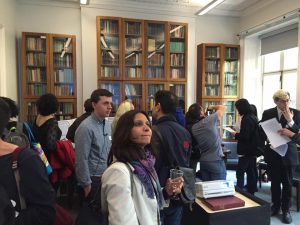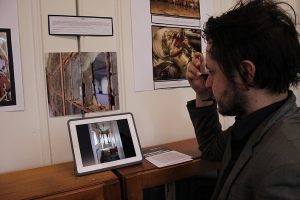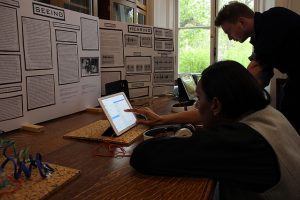by Dylan Williams
As part of Birkbeck’s Arts Week 2016, participants in the MA Contemporary Literature and Culture staged an exhibition responding to the question ‘What is the Contemporary?’. The disparate variety of the contributions spoke not only of the productive (if not problematic) nature of this question, but also demonstrated the variety of creative expertise and interests enjoyed by the course’s students and staff.
Assembled for visitors on Wednesday 18th May, the exhibition somehow managed to pack in the following: a photographic engagement with hybridity in London shopfronts, a live feed of Tweets as they happened, a reading of poetry generated from the experience of contemporary London, an innovative exploration of ways of seeing, hearing, reading and writing, and photography interrogating the role of the computer and the nuclear in our contemporary cultural psychology. At first glance the thematic and formal disparities between the individual pieces served to confound any conclusive definition of ‘the contemporary’. Instead the exhibition constituted a loose assemblage of different artistic adventures spring-boarding from considerations of the term.
For Terry Smith ‘contemporary’ is a word so variously used that it has become ‘empty as a signifier’. [1] The exhibition was a positive response to Smith that embraced the floppiness of the term. The attitudes of the different practitioners to their wider cultural context demonstrate this. Adopting modes of witnessing, reassessing and de-familiarising the pieces served to flag-up more and more cultural material for consideration under the banner of the ‘contemporary’. The signifier was loaded up rather than worked out. The exhibition, in other words, sought to stretch and requalify the concept – to make it new.
This says something about the nature of studying ‘the contemporary’. In few other places in the Humanities can we find a term so temporally and materially mobile. Despite their problems terms like ‘modern’ and ‘postmodern’, and while we’re at it ‘medieval’ or ‘Renaissance’, all point the scholar towards largely periodized and packaged-off areas of cultural attention. The ‘contemporary’ is different. It is a term continuously ‘under construction’, without lasting temporal borders or a complete canon. Opening itself to innovations in culture as they happen, the term can never be closed off. Scholars of the ‘contemporary’ operate on constantly shifting sands.
The practitioners behind the exhibition at Birkbeck demonstrate a way of coping with, and indeed harnessing, the instabilities of this area of study. By eschewing any sort of grand characterisation of the ‘contemporary’, the artists urged the viewer into an alternative mode of critical reception. Differences, rather than trends, were the order of the day, and were urged on the viewer as the main focus for attention. Echoing Agamben’s assertion of the anachronistic dissonance of the contemporary [2], the exhibition gestured us towards, and revelled in, the un-synthesised differences in contemporary culture.
Indeed, the prevailing feel of experimentation and play across the exhibition reminded us that there is always the latent potential in new works to complicate, recalibrate, even refute our established cartographies of culture. The exhibition reminded us, too, that the raw cultural material thrown up by the contemporary moment always holds an implicit challenge to the critic to cut a place for it in our understanding of cultural history. To paraphrase Smith, to be contemporary is to adopt ‘a way of being in or with time’ [3] that, as yet, remains unfixed in its relationship to the traditions of the past.
If the exhibition at Birkbeck answered its question it was only to remind us this – that the contemporary is a test chamber.
References
[1] Terry Smith, ‘Contemporary Art and Contemporaneity’, Critical Inquiry 32:4 (2006), 681-707, 696.
[2] Giorgio Agamben, ‘What is the Contemporary?’ in What is an Apparatus? and Other Essays, trans. David Kishik and Stefan Pedatella (Stanford: Stanford University Press, 2009)
[3] Smith, ‘Contemporary Art and Contemporaneity’, 702.





Recent Comments